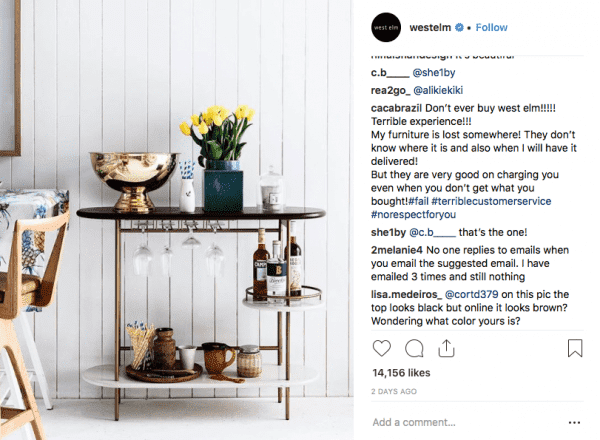

Alli, a tech executive from Colorado, has been waiting for her West Elm order for months.
She placed her order in June. This September, sick of waiting for her item, Alli called West Elm customer service to inquire about the status of her order. After being passed from one customer service agent to another, Alli told me in an email, she finally turned to Twitter, where her messages went unanswered. She also tried Facebook, where West Elm requested she take down her post to protect her privacy, since the post contained her order number; and email, which was likewise ignored. Finally, on September 8, after months of silence, Alli received a response from West Elm customer service via Facebook messenger.
They told her that her June 9 order had been held up by a glitch that only the internet technology department could fix. Finally, she said, through “literally begging” someone in order fulfillment, she got someone from the employee-only supervisor line on the phone — which made little difference. “That order is sitting in a state that says it’ll be ready for delivery between 9/20 and 9/27,” Alli said. “No one has contacted me.”
Customers are growing increasingly frustrated with the company — and they’re flocking online in a chorus of disgruntlement
Alli’s experience may seem extreme, but it isn’t. All across the internet, comments, blogs, tweets, and Facebook posts can be found protesting the home furnishing store’s customer service and delivery. Despite the brand’s on-trend designs and accessible price point, customers are growing increasingly frustrated with the company — and they’re flocking online in a chorus of disgruntlement, clogging nearly every one of West Elm’s social media posts with pleas for their late orders or to express rage about a recent phone call with customer service.
This rising tide of customer complaints comes despite the company’s exploding revenue in recent years. If West Elm’s performance gets better by the year, why is its consumer experience stuck in the Dark Ages?
How West Elm became millennials’ home decor retailer of choice
West Elm was founded by Williams-Sonoma in 2002, just as millennials were aging into adulthood yet before the financial crisis of 2008 sent American bank accounts plunging. The company struggled to pull a profit until 2010, when Jim Brett (now at J.Crew) was brought from Anthropologie to West Elm to turn it around. According to Brett, focusing on brick-and-mortar stores — rather than online, as so many retailers were at the time — was crucial to the brand’s rebirth.
“I was reading all these reports that were down on retail brick and mortar, saying it’s all about online,” he told Fast Company in 2014. “I think brick and mortar is an amazing opportunity to use our stores and our store staff as a vehicle to truly engage with the community in a way no other retailers are doing.”
West Elm launched West Elm Market in 2012, a “true neighborhood destination” that combined mostly American-made home goods and garden supplies with community workshops. The first location, in Brooklyn, features a coffee shop and locally made items: New York magazine called local businesses “the soul — and main concept — of the place.”
In 2015, West Elm launched West Elm Workspace, a commercial arm of the brand that services office and professional spaces; the following year, it announced West Elm Hotels, with locations planned for Indianapolis; Portland, Maine; Oakland, California; Detroit; Minneapolis; and Savannah, Georgia. The first locations are set to open in 2019.

Workspace and Hotels fit into Brett’s revamped vision of West Elm. The goal is to feel less like a mere retailer and more like a holistic, lifestyle-focused brand that caters to multiple aspects of a customer’s life. By pulling in local artisans and makers, designing for workspaces, and even offering craft and cooking classes in its stores, West Elm is coming at young consumers from every direction. And like CB2, Crate & Barrel’s younger, slightly less expensive line, with West Elm, Williams-Sonoma is targeting millennials — young, fashionable, and finally ready to graduate from Ikea and Target to “grown-up” or “real” furniture. (William Sonoma declined to comment for this article.)
Sarah Rottenberg, the executive director of integrated product design at the University of Pennsylvania, believes West Elm’s aim of authenticity and knack for storytelling is key to its success.
West Elm “highlight[s] stories that people care about: stories about sourcing products from craftspeople, where the products come from, and how those products can fit into people’s life,” Rottenberg wrote in an email. Further, she says, her own research has shown that “practicality is a critical attribute for millennials purchasing products. They signal that they are adults making responsible decisions and West Elm’s price point and style is responsible — not too expensive, not too flashy, flexible enough to fit into multiple environments but not lacking style or personality.”
Priya Raghubir, a business and marketing professor at New York University, says while brands typically engage with the traditional “3C framework” — customer, company, competition — West Elm has rocked the boat with its addition of a new C: community. This recent focus on community has given West Elm a leg up in the industry, says Raghubir.
“The importance of a brand that engages with community is particularly important to the younger demographic that West Elm targets,” she says. “One of the critical differentiators between West Elm and its competitors is that its position does not rely on price points (like Ikea), or design (like its sibling Williams-Sonoma), or only on customer service, but on engaging with a larger community.”
And it appears to be working. Williams-Sonoma closed out 2017 with financial gains across all its properties (including Pottery Barn, Williams-Sonoma, Mark and Graham, and Rejuvenation), but West Elm, which grew by 12.3 percent, was the real winner. Laura Alber, Williams-Sonoma’s president and CEO, called West Elm “one of the fastest-growing, most profitable brands in the industry,” with plans to grow on the pipeline.
But all this raises a question: Why does a growing, successful brand that purports to care about “community” have such massive customer service issues?
West Elm customers are mad as hell
A week after Alli and I talked about her customer service issues with West Elm, she emailed me again. “The delivery range on the replacement order they created for me has moved from September 20-27 to October 1-8,” she wrote. It has been four months since she placed her order.
When Diego, who lives in St. Louis and asked that his last name not be used, ordered his table in July, he had been a regular West Elm customer for years. But his latest experience, he says, may be his last. In an email to West Elm that Diego forwarded to me, he wrote, “I have talked to over 20 people on your team and have even emailed you before. No one has provided me a solution and many people have lied to me on the way. No one has replied to my previous email in over a month. And someone just hung up on me. I do not know what to do anymore.”

According to an email to West Elm that Diego showed me, his table was supposed to be shipped to his local store, but when the delivery window came and went, he called customer service, inquiring about his misplaced table. After two weeks of back-and-forth between Diego and customer service, he recalled that a customer service agent admitted that the table appeared to have been totally lost.
Diego then said the customer service agent suggested, how about we cancel the old order, and then, once Diego received his table and some apologetic gift cards, he could get a refund for the first table? Five weeks after he ordered his table, Diego’s order arrived, with the gift cards — and no refund.
More than two months after Diego’s debacle with West Elm began, he finally received the check he was owed for $817. “The West Elm customer service is extremely disorganized: I believe they have major communication problems within the company,” Diego told me. “The other alternative is that they are all liars. I lean toward the first.”
Muriel Vega, a writer based in Atlanta, had significant issues with her West Elm order two years ago. After ordering a bunch of furniture for her new home, including a dining room table, coffee table, and sofa, she sold most of her old furniture on Craigslist. But her West Elm order was AWOL for more than two months, at which point the company finally told her it had lost the order. Muriel attempted to cancel the entire order, a request she says West Elm refused, since it claimed her order had already shipped.
“After calling/emailing/tweeting every other day for their status,” says Muriel, her table finally arrived; she was “allowed” to cancel the order for the couch, she says, and ended up purchasing a couch from a competitor.
These anecdotes are hardly the exception. On West Elm’s Facebook, customers cajole, plead, and complain about their faulty items, missing orders, or rude customer service experiences. Twenty-five recent West Elm Facebook posts had a total of 449 total comments; of those, 290 were negative, meaning 64 percent of the comments counted during a recent time period were from customers unhappy about their order in some shape or form (I did not count multiple negative comments from one person on a post).
In an interview with a West Elm employee who asked to remain anonymous to avoid professional repercussions, they defended the amount of negativity that clusters on the brand’s social media.
“I would say [customer service complaints on social media] are pretty regular,” they told me. “If they have a problem, they’re gonna be like, ‘I have a problem, this company is horrible, I didn’t get my couch!’ But something to keep in mind is that if people have a positive experience they’re not necessarily going to go on our social and be like, ‘I had a really great experience getting my couch! It came on the day I wanted it! Thanks!’”

This rings true — I ordered a coffee table from another brand recently, and while it arrived on time and was exactly what I wanted, I didn’t run to the brand’s social media to praise them — but just to make sure that West Elm’s surplus of negative comments (and lack of positive ones) was exceptional, I compared West Elm Facebook comments to those of its closest competitors in style and scope: Crate & Barrel and the online furniture emporium AllModern.
Compared to West Elm’s 74 percent of comments on its page being negative, Crate & Barrel’s was … 0 percent. There were fewer comments in general, but in my count of the 25 most recent Facebook posts at the time of writing, out of 84 total comments, there was not a single one complaining about delivery issues, customer service problems, or product quality dissatisfaction. I was so shocked, I asked Crate & Barrel customer service if they ever deleted comments (besides those that are offensive or hateful, such as racist diatribes or sexist jabs) and was told that the company did not delete customer service complaints from its Facebook page.
AllModern received 75 Facebook comments on its 50 most recent posts, out of which three were to complain about the company’s customer service or product quality; likewise, AllModern confirmed to me that it does not delete comments remarking on its quality or other issues.
This frustration from customers is reflected on Yelp as well. On Crate & Barrel’s New York City Yelp page, the brand received 134 reviews, with a rating of 3.5 stars; West Elm’s NYC page has 2.5 stars for 110 reviews. Room & Board, a similar brand in terms of aesthetics and price to West Elm and Crate & Barrel, has 42 comments on Yelp and a 4-star rating. The three companies have similar Yelp ratings for their Bay Area locations: Room & Board San Francisco has 354 reviews and a 4-star rating; Crate & Barrel’s San Francisco location has 202 reviews and a 3.5-star rating; and West Elm, located in the nearby city Emeryville, has 90 reviews and 2 stars.
Further, while Room & Board, Crate & Barrel, and AllModern all have customer product reviews on their sites, West Elm does not; of all Williams-Sonoma brands, only its high-end kitchenware brand Williams-Sonoma, which differentiates itself from the others by selling primarily products made by other companies, allows reviews on site. This makes it difficult to discern how a particular item will perform.
“They started leaking feathers all over the place, the cushions didn’t hold their shape. … I sat on one of the couches and the front beam snapped in half.”
And plenty of customers appear to have qualms about the quality of their West Elm products that they’re unable to share in the form of reviews. In a post on Medium, Bay Area engineer Luke Millar detailed the substandard quality of his West Elm sofas. “They started leaking feathers all over the place, the cushions didn’t hold their shape. … 3 and half months later, I sat on one of the couches and the front beam snapped in half.”
A Reddit thread from May depicts similar issues. “I ordered a dresser from West Elm,” wrote user u/macaron2017. “And it was defective the day it arrived.” Another redditor, u/Capt_FancyPants, claimed they worked for Homewings.co.uk, an online interior design firm, and that West Elm was on the company’s blacklist. “Westelm are on the AVOID AT ALL COSTS list of suppliers,” they said.
“I have a thing I say to all my clients,” said Denise Gianna, an interior designer in Beacon, New York, on a phone call. “How long do you want your sofa to last? Three years, five years, 10 years, forever? Because that is basically the level that you can expect depending on where you buy and what you buy.”
I told her my West Elm sofa, which has busted buttons, pilly upholstery, and sagging back cushions, is four years old. “Well, that’s right in that five-year range,” she responded. My $1,500 sofa was only holding up slightly worse than expected.
“West Elm is trying to position themselves as the next step up from your college Ikea,” she said. That was absolutely true for me and several of my friends: Once we got our first grown-up salaries and could save up a couple thousand for a decent sofa, many of us immediately turned to West Elm. “The couch would be the most prominent piece of furniture in our small apartment and our first big purchase together ,” wrote Anna Hezel in her seminal piece for The Awl “Why Does This One Couch From West Elm Suck So Much?”
But is West Elm really that much better than Ikea — or, for that matter, whatever cute old piece of furniture you can pick up for a couple hundred dollars at a flea market? Gianna doesn’t necessarily think so, noting that it’s more important to research the materials and construction of the item than where you’re buying it. “If you wanted to buy all your furniture from Ikea, you certainly could do it,” she told me. “I would expect it to last 15 years depending on what you’re buying.”
Mathieu Zastawny, an industrial designer and frustrated former West Elm customer, agrees. “We keep trying to move away from Ikea thinking it’s cheap stuff, but honestly, even if they’re cheap, they stand the test of time pretty well if you’re a little careful,” he said.
West Elm customer service is struggling with outdated technology and poor support
Waiting months for a brand new but broken couch to be replaced or a refund on an errant charge for hundreds of dollars can be frustrating. But judging from Glassdoor reviews, it can also be immensely stressful on Williams-Sonoma customer service employees, many of whom service every brand underneath the Williams-Sonoma umbrella as well.
“A very cheap company who doesn’t reward their employees anymore since Laura Alber took over. I handle a LOT of angry customer calls because the product at West Elm and Pottery Barn is so flimsy,” said one customer service agent based in Las Vegas on the company’s Glassdoor page. “A lot of the business processes should be reviewed for improvement because we do not put the customer first,” wrote another, based in Kettering, Ohio. Another lengthy review writes, “Customer service in itself is pretty much the same where ever you go, but at THIS company it’s OVERKILL. … Calls entail shipping issues, delivery issues, payment issues, damaged merchandise, item not as depicted..and so on. IT’S A LOT!”
According to another Glassdoor review, one of the biggest issues plaguing the Williams-Sonoma customer service team is outdated computer technology, leading to lagged notifications of back-ordered or missing items or insufficient data on the location of a customer’s order. “Ordering system for most of the concepts (except Pottery Barn Teen) are Dos-based dating back to the 70’s,” wrote the Columbus, Ohio-based reviewer.
“The employees in customer service don’t know because their tracking and inventory system is so horribly managed”
Another reviewer also mentioned the company’s faulty computer infrastructure. “The employees in customer service don’t know because their tracking and inventory system is so horribly managed,” wrote another particularly incensed Glassdoor reviewer. “One piece could be at your local hub. It could be in transit! Chances are it never left, but you think they’re going to tell you the truth?”
There are some reviews that reflect a more positive experience. One Atlanta-based reviewer said the company’s helpful management and good discount made for a positive working environment. Another reviewer, based in Phoenix, praised the company’s “empowerment” motto, and that it’s “a great company that treats their employees with respect.” Nevertheless, a total of 74 Williams-Sonoma customer service team member reviews amount to an overall 2.4-star rating for the position.
According to the West Elm employee I interviewed, improving the customer experience is a “priority” of the company. “I’m not sure if they’re planning on changing anything or restructuring anything or what the timeline is for any of that,” they told me. “But I do know that it is something that they are aware of and want to improve.”
Williams-Sonoma declined to comment for this article, so I was unable to confirm if, and how, the company plans to improve its customer service and delivery. But one law firm, Gutride Safier, is currently exploring allegations that West Elm classifies products as in stock when they’re not, leading to delivery delays, as well as the brand’s lack of clarity surrounding the its “flat rate delivery.” If the investigations lead to a lawsuit, perhaps West Elm will be more quickly compelled to find solutions to its service and delivery woes.
It’s the economy, stupid
It makes sense to approach furnishing your home as a staircase: gradually buying more expensive, nicer-seeming things as our paychecks begin to grow. West Elm, it would appear, recognized that as image-oriented millennials grew up, they’d need to furnish their homes with nicer things, but after having just survived an intense economic devastation as the 2008 financial crisis, and with less economic stability than previous generations, they’d maybe be less willing to spend significant amounts of money on single items than their parents had. So West Elm, and other low- to mid-range brands like CB2, swooped in.
“We’re a much bigger throwaway culture,” says Gianna. “A company like West Elm is playing the need to have something that looks and feels high-end but is also throwaway in time.”
So maybe I, and my friends, did it wrong. Maybe buying mid-range furniture and expecting it to actually last as long as our parents’ couches was a mistake; probably it’s better to buy an old sofa from a flea market, drive it home in a U-Haul, and plan to reupholster it on the cheap if necessary.
At the very least, it’ll arrive at your apartment when you expected it to.
Want more stories from The Goods by Vox? Sign up for our newsletter here.
Sourse: vox.com





